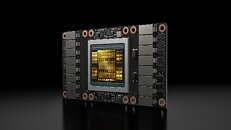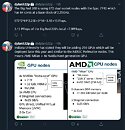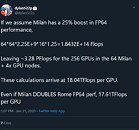Monday, February 3rd 2020

NVIDIA's Next-Generation "Ampere" GPUs Could Have 18 TeraFLOPs of Compute Performance
NVIDIA will soon launch its next-generation lineup of graphics cards based on a new and improved "Ampere" architecture. With the first Tesla server cards that are a part of the Ampere lineup going inside Indiana University Big Red 200 supercomputer, we now have some potential specifications and information about its compute performance. Thanks to the Twitter user dylan552p(@dylan522p), who did some math about the potential compute performance of the Ampere GPUs based on NextPlatform's report, we discovered that Ampere is potentially going to feature up to 18 TeraFLOPs of FP64 compute performance.
With Big Red 200 supercomputer being based on Cray's Shasta supercomputer building block, it is being deployed in two phases. The first phase is the deployment of 672 dual-socket nodes powered by AMD's EPYC 7742 "Rome" processors. These CPUs provide 3.15 PetaFLOPs of combined FP64 performance. With a total of 8 PetaFLOPs planned to be achieved by the Big Red 200, that leaves just a bit under 5 PetaFLOPs to be had using GPU+CPU enabled system. Considering the configuration of a node that contains one next-generation AMD "Milan" 64 core CPU, and four of NVIDIA's "Ampere" GPUs alongside it. If we take for a fact that Milan boosts FP64 performance by 25% compared to Rome, then the math shows that the 256 GPUs that will be delivered in the second phase of Big Red 200 deployment will feature up to 18 TeraFLOPs of FP64 compute performance. Even if "Milan" doubles the FP64 compute power of "Rome", there will be around 17.6 TeraFLOPs of FP64 performance for the GPU.
Sources:
@dylan522p(Twitter), The Next Platform
With Big Red 200 supercomputer being based on Cray's Shasta supercomputer building block, it is being deployed in two phases. The first phase is the deployment of 672 dual-socket nodes powered by AMD's EPYC 7742 "Rome" processors. These CPUs provide 3.15 PetaFLOPs of combined FP64 performance. With a total of 8 PetaFLOPs planned to be achieved by the Big Red 200, that leaves just a bit under 5 PetaFLOPs to be had using GPU+CPU enabled system. Considering the configuration of a node that contains one next-generation AMD "Milan" 64 core CPU, and four of NVIDIA's "Ampere" GPUs alongside it. If we take for a fact that Milan boosts FP64 performance by 25% compared to Rome, then the math shows that the 256 GPUs that will be delivered in the second phase of Big Red 200 deployment will feature up to 18 TeraFLOPs of FP64 compute performance. Even if "Milan" doubles the FP64 compute power of "Rome", there will be around 17.6 TeraFLOPs of FP64 performance for the GPU.



172 Comments on NVIDIA's Next-Generation "Ampere" GPUs Could Have 18 TeraFLOPs of Compute Performance
I have a feeling these rumors are true, mainly cause they are afraid of Big Navi.
Glorious time for gamers! Rejoice brothers! Glory is here!
I dont think were getting 2080ti performance cheaper than $699
Lets say big navi comes out and the performance of it is better than the rtx 2080ti.
Nvidia will drop the price of the 2080ti to match the big navi price
then when the ampere card launches later on, nvidia will jack up the top tier card back to $999 saying its faster to justify the cost
They cant even get the small navi to work properly.
Ampere will compete with turing and next gen consoles (and their desktop equivalents).
1:1 ratio is an option but it would come with massive die space cost which again, I don't see them doing it.
Something else is going on.
So every "big GPC" will grow to 1536 Cores, so with 6 GPC we reach 9216 Cores.
At 1.9 GHz we reach 17.51 TFlops FP64.
Nvidia did the big(6 TPC) and small (4 TPC) GPC experiment the first time with Turing, i bet that was for a reason.
Turing was also the first time that a non-top-tier chip like the RTX 2080 got 6 GPC when the top-tier has also 6 GPC.
Going over 6 GPC would likely drive the chip complexity without any significant gains, but putting more horsepower in every GPC makes sense.
Maybe Ampere brings even more variance in TPC count per GPC.
12 TPC = 1536 Cores
10 TPC = 1280
_8 TPC = 1024
_6 TPC = _768
at 6 GPC that would bring 9216 or 7680 or 6144 or 4608 Cores (TU102)
Nvidia calls anything tu104 based their high end and AMD seems happy to follow so there is no useful information in what you cited.
flood the market meaning disrupting the GPU market.
As you read, "change the 4k gaming as ryzen did for CPUs", in my words outstanding. What other conclusion would you have in mind?
It's just how I get it. Will it be true? How could you or I tell?
Is there a card coming or not? How does it perform?
How will it perform? Hasn't been revealed yet. CES 2020 hold your horses.
A cute little Cardinal birdie told me that Nvidia will not release Ampere until AMD releases RDNA2. And another cute little birdie, this time the birdie was a Blue Jay told me AMD won't release RDNA2 until Nvidia releases Ampere.
Which cute little birdie will you believe?Q1 Launch Ampere Server GPUs.
Q2 Release Ampere Server GPUs & Launch Ampere Desktop GPUs.
Q3-Q4 Release Ampere Desktop GPUs.
Or listen to the birdies.